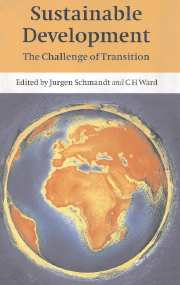Book contents
- Frontmatter
- Contents
- List of contributors
- Foreword
- Preface
- 1 Challenge and response
- 2 National self-interest in the pursuit of sustainable development
- 3 Uneconomic growth: Empty-world versus full-world economics
- 4 Population and consumption: From more to enough
- 5 Spirituality and sustainability
- 6 Leadership skills for sustainable development
- 7 The role of science: Guidance and service
- 8 Economic tools, international trade, and the role of business
- 9 Stakeholders and sustainable development
- 10 From idea to action: The role of policy
- Index
3 - Uneconomic growth: Empty-world versus full-world economics
Published online by Cambridge University Press: 17 August 2009
- Frontmatter
- Contents
- List of contributors
- Foreword
- Preface
- 1 Challenge and response
- 2 National self-interest in the pursuit of sustainable development
- 3 Uneconomic growth: Empty-world versus full-world economics
- 4 Population and consumption: From more to enough
- 5 Spirituality and sustainability
- 6 Leadership skills for sustainable development
- 7 The role of science: Guidance and service
- 8 Economic tools, international trade, and the role of business
- 9 Stakeholders and sustainable development
- 10 From idea to action: The role of policy
- Index
Summary
That which seems to be wealth may in verity be only the gilded index of far-reaching ruin …
JOHN RUSKIN, Unto This Last, 1862.Abstract
Uneconomic growth is growth that increases environmental and social costs by more than it increases production benefits. It is theoretically possible, yet appears anomalous within the neoclassical paradigm. Nevertheless, it is empirically likely that some northern countries have already entered a phase of uneconomic growth. Why does the dominant neoclassical paradigm make uneconomic growth seem anomalous, if not impossible? Why, by contrast, does uneconomic growth appear as an obvious possibility in the alternative paradigm of ecological economics? Although the neoclassical paradigm permits growth forever, it does not mandate it. Historically the mandate came because growth was the answer given to the major problems raised by Malthus, Marx, and Keynes. But when growth becomes uneconomic we must find new answers to the problems of overpopulation (Malthus); unjust distribution (Marx); and unemployment (Keynes). However, national policies required to deal with these three problems are undercut by “globalization” – the current ideological commitment to global economic integration via free trade and free capital mobility. The consequent erasure of national boundaries for economic purposes simultaneously erases the ability of nations independently to enforce policies for solving their own problems of overpopulation, unjust distribution, and unemployment. Many relatively tractable national problems are converted into one intractable global problem, in the name of “free trade”, and in the interests of transnational capital.
Uneconomic growth in theory
Growth in GNP is so favored by economists that they call it “economic” growth, thus ruling out by terminological baptism the very possibility of “uneconomic” growth in GNP.
- Type
- Chapter
- Information
- Sustainable DevelopmentThe Challenge of Transition, pp. 63 - 78Publisher: Cambridge University PressPrint publication year: 2000
- 2
- Cited by



